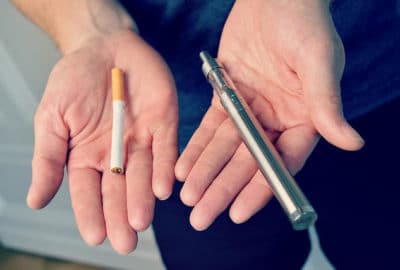How can we improve endometriosis treatment?
Wednesday 26th Jan 2022, 12.30pm
Did you know there are different types of pain? In this episode of the Big Questions Podcast, we chat to Dr Lydia Coxon, a researcher in the Nuffield Department of Women’s and Reproductive Health at Oxford. Lydia is looking at the mechanisms that cause pain in patients with endometriosis – a common gynaecological condition where tissue that normally grows inside the womb is found outside the womb. Through her research she hopes to better understand the type of pain that endometriosis causes, so that it can be treated more effectively.
Emily Elias: Endometriosis can be really painful. It’s where you get tissue growing in the old lady garden where it shouldn’t be growing. Pain is a tricky thing to study. Some researchers are even questioning if they’re treating the right type of pain when it comes to endometriosis and, so, on this episode of the Oxford Sparks Big Questions podcast, we are asking how can we improve endometriosis treatment?
Hello, I’m Emily Elias and this is the show where we seek out the brightest minds at the University of Oxford and we ask them the big questions. For this one, we’ve found a researcher who’s really into studying pain and questionnaires.
Lydia Coxon: I’m Lydia Coxon. I’m a research scientist in women’s and reproductive health and I investigate chronic pelvic pain in women specifically endometriosis associated pain. I look at the mechanisms that cause the pain, what the pain is like for these women and then look at how potentially we could better treat it and how we could improve women’s lives with pain basically.
Emily: I’m not super familiar with endometriosis. What is endometriosis?
Lydia: So, endometriosis is a really common gynaecological condition. It affects one in ten women of reproductive age. What it is basically, it’s where the tissue that normally grows inside the womb is growing somewhere outside of the womb. So, it can either be sort of on your ovaries or somewhere else in your pelvis.
Often this can be really, really, painful. Because this tissue can sort of menstruate, and go through the normal cycle with your hormones, but it’s really mixed. So, for some people it can be very painful, for some people they don’t experience any pain with endometriosis. So, it’s a real mixed picture of what the symptoms are like but it’s really, really, common.
Emily: How do you get a diagnosis of it? Do you just get a blood test or how easy it… for it to figure out that you do in fact have endometriosis?
Lydia: So, unfortunately, currently, it’s quite difficult to diagnose endometriosis. So, whilst there’s lots of research going on trying to find better ways to diagnose it, at the minute, the only way to get a full diagnosis, clinical diagnosis of it, is to have surgery.
So, what clinicians do is they do normally keyhole surgery. So, they make a small incision and have a look inside with cameras and have a look and then they visually see endometriosis. Then sometimes they’ll take samples and then take it back to the labs and look at it and confirm that it’s endometriosis.
So, that’s sort of the gold standard way of diagnosing endometriosis. There isn’t unfortunately a urine test or a blood test or anything like that. We are hoping… there’s lots of people looking into it and hoping that we could do another way of diagnosing it because there is a really long diagnostic delay in endometriosis. So, on average, it’s about seven years for a diagnosis.
Emily: Ah, seven years? That is a really long time to wait for a diagnosis if you’re in pain. Okay, so, there are different kinds of pain. What kind of pain are we talking about here?
Lydia: So, there’s lots of different types of pain. So, when we’re talking about pain in this setting, I mean, I’m sure everybody has experienced pain of some sort. So, whether you’ve stubbed your toe, whether you’ve burnt your hand on something hot, everyone has experienced some sort of pain.
Generally, when we’re talking about pain you have some sort of damage, like, on your skin, for example, or in your bones. That damage is then- nerves carry that signal to the spinal cord and then up to your brain and then you perceive that as pain.
Now we call that a sort of no susceptive pain and that’s… if it’s just a short‑term thing that’s not a problem. Now if you have pain for a long, long, time that can become chronic pain and when you have chronic pain there’s changes. So, there can be changes in your sort of extremities, so, where the damage is caused, so, in your hands, or in your feet, or where the damage has happened, or in your spinal cord, or in your brain.
That can mean that the volume of the pain is slightly altered or how you perceive that pain can be slightly changed or how the nerves are firing can be slightly changed. So, that’s sort of what… chronic pain is slightly different to just the normal acute pain that everyone experiences and, as well as that, there’s also different types of pain. So, one of those is… another type of pain is neuropathic pain.
Emily: What is exactly is neuropathic pain?
Lydia: So, neuropathic pain is when there’s damage to the nerves themselves. So, the nerves that carry the signals to the brain are themselves injured. So, they send signals when they shouldn’t be. So, then your brain is thinking that there’s pain when there’s no damage to any of the tissues, so, those pain signals are just being sent to the brain when they shouldn’t be.
That type of pain is often experienced differently by patients. So, they’ll describe it in a different way. So, they might say that they have a stabbing pain, or they might say that they perceive a tingling sensation in the area like pins and needles. It also needs to be treated a different way.
So, it doesn’t respond so well to your classical Paracetamol or Ibuprofen, it needs to be treated by a different sort of battery of drugs. So, that’s sort of what we’re thinking about when we talk about neuropathic pain. It’s that sort of different type of pain to your no susceptive pain.
Emily: So with endometriosis, if you’ve gone through this procedure, you’ve had surgery to prove that you do, in fact, have it is it treated as no susceptive or is it traditionally treated as neuropathic pain?
Lydia: Currently it’s traditionally thought of as no susceptive. So, we traditionally treat it with no susceptive treatment, so, Ibuprofen and Paracetamol. Surgery itself is sort of thinking of it as a no susceptive thing. So, we’ll take away the tissue damage and it will resolve itself.
Now what myself and my colleagues are looking at now is thinking if it’s neuropathic pain, what do we need to do slightly differently? So, do we need to look at now trying to trial different drugs that we know work well in neuropathic pain conditions? We need to try now and trial those drugs in endometriosis or in women with endometriosis who seem to have a neuropathic component.
Emily: So, you have a hypothesis that we could be seeing a neuropathic pain component in patients with endometriosis? You’ve created a study that’s working off a questionnaire to ask women about their pain to see if it supports, or disproves, your theory?
Lydia: So, why we think there might be neuropathic pain in endometriosis, there’s a sort of few mechanisms why we think there could be some nerve damage. So, one of them is that the endometriosis… the bits of tissue that sort of are growing outside of the womb that look like the inside of the womb, so, those sorts of bits of tissues that I was sort of explaining about before, they have new nerves growing through them.
These new nerves, firstly, could be getting squished and if those nerves are squished that could be damaging the nerves themselves. So, that could give you a sort of neuropathic pain. Also, those nerves are sort of bathed in a lot of the sort of soup that’s full of lots of different molecules that could sensitise them in a way and sort of damage them in that way. Also, we know that we need to have surgery to diagnose endometriosis.
So, obviously, surgery involves cutting through layers of skin and layers of nerve and any type of surgery is associated with risks of post-surgical pain because of the potential to damage nerves and that damage leading to neuropathic pain. So, we know that there are mechanisms which could give rise to neuropathic pain and endometriosis.
So, we wanted to look in our study to see if there was any evidence that there could be a neuropathic component to endometriosis associated pain. We think that there’s a mechanism there.
Emily: How tricky is it to determine what kind of pain somebody is experiencing? Because, I mean, pain can be so subjective to each person. How do you go about quantifying this in people?
Lydia: Yes, yes, exactly. Pain is completely subjective. So, everybody experiences pain completely differently and everybody can experience pain differently in different situations and on different days as well which also makes it harder as well.
I think one of the things that is so useful is quite often how you would describe your pain can quite often give you an indication of what mechanisms are at play. So, for example, I don’t know if you’ve ever felt unwell and you sort of have a gut feeling.
If you pull a muscle, you sort of know whether you want something warm or something cold on it and you sort of have that natural instinct of what you know would make it feel better. If you’ve ever experienced that it’s a similar sort of idea.
So, if you have certain descriptors, we can sort of think that that’s a certain type of mechanism at play we think behind it. So, stabbing, shooting, tingling in the area, pain like electric shocks. If you hear that as a clinician, you might be starting to think that that could be a neuropathic pain component as opposed to sort of a dull aching pain or a throbbing pain potentially.
So, we can… the way you describe your pain can sort of give you an indication of the mechanisms behind it but there’s also other ways. So, if we use questionnaires or verbal descriptions which is very useful in certain settings. So, clinically, it can be useful in a waiting room, clinicians could get you to fill in a questionnaire.
Or in an assessment and things you could do it verbally, it would be quite straightforward, or we can do it online. I did it on an online service today and that’s quite straightforward and easy to get big numbers. Obviously that only gives you an indication, it can’t give you a complete diagnosis of anything because it’s only sort of giving you a rough idea so to speak.
Emily: Does there seem to be any evidence that women do have neuropathic pain?
Lydia: So, we sort of found that there was a proportion of people who had neuropathic like pain in endometriosis. So, that group seems to be really interesting, and we know that they probably wouldn’t respond to the normal treatment that we are generally offering them.
So, we need to start looking at these different approaches and start looking at neuropathic pain as a potential new avenue to sort of explore in endometriosis associated pain.
Emily: So, how game changing would this be for a patient if they all of a sudden kind of can be able to identify what type of pain this is to then get effective treatment that would work for them?
Lydia: So, without wanting to promise the world, if you could find what was causing the pain and then give them the treatment that would work for that mechanism, that would be life changing, right? I mean, not all mechanisms would we necessarily find the right treatment and it would each have to be personalised.
If we can ultimately get to a point where we have personalised medicine and we can have someone walk in with pain and we can say, “Okay, here are a battery of tests. There’s questionnaires, there’s these assessments, there’s this, that, and the other, maybe a brain scan, or whatever.
Then from all this information we can determine what mechanisms are really contributing to keeping that pain ongoing for you and these are therefore the best treatments for you, maybe this drug, maybe this therapy, maybe this physio. Of course, if that can then treat their pain, I mean, that would change their life.
That would be what every pain researcher is working towards, a point where a person in pain can walk in and we can take their pain away. Ultimately, hopefully, we will get there. I don’t think it will be tomorrow and I don’t think it will be next year but ultimately baby steps and we will get there hopefully.
Emily: So, right now we’re baby stepping with the questionnaire. I mean, what has it been like working with patients who are going through this journey of having endometriosis and talking to them about their type of pain?
Lydia: I think it has been really… on days it has been really hard. On days it’s really hard to hear how difficult it is for some women with endometriosis and how much harder their lives can be because of how they suffer.
I think the flip side of that is when you see how much they are willing to do for research and how happy they are to take part in studies and give up their time and they’re happy to sit in a chair and for me to prod and poke at them to see… to help us understand the disease a bit better, I think it really inspires me to work hard and sort of reaffirms why we are doing this.
I think if there was ever a day where I’m thinking, “Gosh.” I think everyone always probably has a day on a Monday morning where you’re like, “Why do I do this? Why am I bothering? I’m tired. Oh.” Then you speak to somebody and you’re like, “No, this is why I’m doing it.”
Because they are saying, “No, thank you so much for doing this research because endometriosis… I don’t want anyone else to suffer how I have suffered.” Yet you can put me in a brain scanner, you can poke at me, yes, please, anything that will help the future of endometriosis and I think that really puts it into perspective.
Emily: So, if you do determine that, like, boom, yes, there is some neuropathic pain component and the drugs that we have to treat them are already approved to treat neuropathic pain, I mean, how far off are we from seeing them put into treatment plans for patients who just have endometriosis?
Lydia: I think those, sort of, studies will hopefully be coming through in the next sort of few years or so would be what I’d hope to see. Obviously, it’s all depending on money and everything like that. So, it all depends on were funding goes and things. I don’t think… I don’t see them being 20 years off at all. I think they can be happening very soon.
I think the science is there and the drugs are there, we just need to test them in this population.
Emily: This podcast was brought to you by Oxford Sparks from the University of Oxford with music by John Lyons. A very special thank you to Lydia Coxon. We are on the internet at Oxford Sparks so check us out. We’ve got other cool science stuff on our website, oxfordsparks.ox.ac.uk. I’m Emily Elias, bye for now.
Transcription by UK Transcription.



